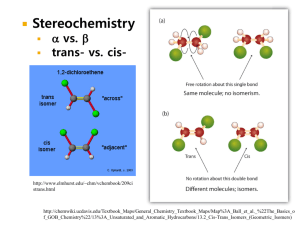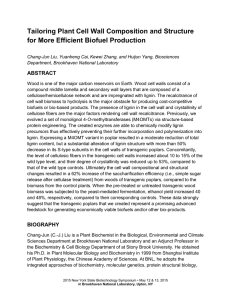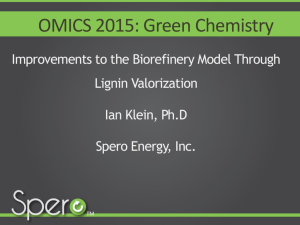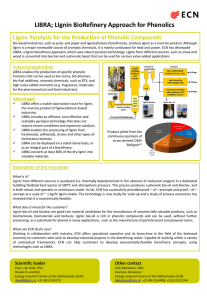Lignin in the Hot-Water Extraction of Sugar Maple: Isolation, Characterization
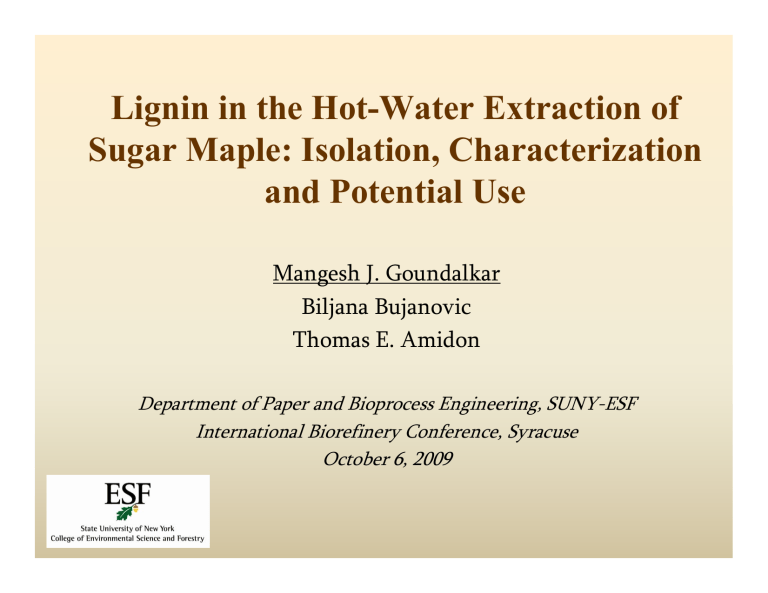
Lignin in the Hot-Water Extraction of
Sugar Maple: Isolation, Characterization and Potential Use
Mangesh J. Goundalkar
Biljana Bujanovic
Thomas E. Amidon
Department of Paper and Bioprocess Engineering, SUNY-ESF
International Biorefinery Conference, Syracuse
October 6, 2009
Overview
• Introduction
-Hot-Water Extraction in the ESF Biorefinery
• Isolation and Analysis of precipitate in the Hot-Water
Extract
• Current Results
• Conclusion
2
Introduction
ESF Biorefinery Scheme
3
Hot-Water Extraction
• Sugar maple wood chips are first extracted with hot-water as per the ESF biorefinery protocol
• Laboratory
Extractions were performed at high temperature – 150 and 160
°
C at different time intervals of 15, 60 and 120 minutes
• Extracts collected were stored for 48 hours prior to filtration in the lab
(< 8
°
C)
• ESF Pilot Plant
Hot water extraction was performed at 160
°
C for 120 minutes and is immediately subjected to filtration
4
Hot-Water Extract Filtration
• Ultrafiltration (UF) was performed in laboratory using a
1000 Da membrane in a stirred ultrafiltration cell
(Millipore) to collect the retentate (UF retentate)
• Ceramic Membrane Filter (CMF) was used in the ESF pilot plant for filtration of Hot-Water extract (CMF retentate)
5
Yields of UF retentate
Yields based on 500 g of OD chips cooked with Hot-Water at a 4:1 liquor to solid ratio green – 150 o C blue – 160 o C
Temp ( o C)
160
160
160
Time
15
60
120
Yield (g)
1.20
9.54
8.84
% yield
0.24
1.90
1.76
6
Preliminary Analysis of Retentate
FTIR analysis of UF retentate
(160
°
C, 120 min)
• UF retentate (160, 120 min) is ligninenriched. FTIR spectrum exhibits characteristic peaks of typical hardwood lignin
• In accordance with Faix’s* lignin categorization dissolved lignin is most probably GS4 lignin type
– 25-50% G-units
– 45-70% S-units
* Faix, O. 1992 , Characterization in Solid State, in Methods in Lignin Chemistry , Springer, 81-106
Lignin- A phenyl propanoid type polymer formed by polymerization of three p -hydroxycinnamyl alcohols
CH
2
OH
CH
2
OH CH
2
OH
OMe MeO OMe
OH
OH OH p -coumaryl alcohol coniferyl alcohol sinapyl alcohol
Softwood is composed of ‘G’ units and hardwood of ‘G’ and ‘S’ units
Lignin
Representative structure of lignin
G S
8
Lignin content
• Acid-insoluble and acid-soluble lignin content of HWE samples
(retentates obtained after UF and CMF)
Sample ID
UF retentate
Conditions
160 o C , 120 min (as is)
Acid ‐ Insoluble (%) Acid ‐ soluble (%) Total lignin (%)
63.2
7.0
UF retentate 160 o C,120 min, pH 2
CMF retentate 160 o C,120 min ( as is)
69.0
86.0
5.5
4.1
CMF retentate 160 o C,120 min pH 2
CMF retentate 160 o C,120 min pH 2, N
2
, 60 o C, 120min
86.4
90.3
4.8
2.0
Mild acid treatment of the retentates increases their lignin content
70.2
74.5
90.1
91.2
92.3
9
LCC
During mild acid hydrolysis benzyl ether bonds between lignin and hemicelluloses
(LCC bonds) may be cleaved*
* Koshijima, T.; Watanabe, T. 2003 , Association between lignin and carbohydrate in plant and other tissue , Springer, 329pp
Characterization
Methods used to characterize retentates:
• NMR
• Nitrobenzene oxidation (S/G ratio)
• Periodate oxidation (free phenolic hydroxyl group determination/PhOH)
• Size Exclusion Chromatography (SEC)
(molecular-weight distribution)
11
Characterization
2D HSQC of UF retentate (160 o C, 120 min, pH 2)
12
Aromatic ring correlations and main lignin bonds are detected
A)
β
-O-4
B)
β
-5
C)
β
-
β
Characterization
13
Characterization
G S
These results are in accordance with FTIR indicating S-enriched lignin (GS4)
14
Characterization
• Nitrobenzene oxidation (S/G ratio )
High ‘S’ content compared to original sugar maple suggests that lignin from fibers (S-enriched lignin) is preferentially dissolved (vessels are characterized by G-enriched lignin)^
Sample ID
UF retentate (160 o C, 120min, pH2)
CMF
S/G ratio
3.6
3.6
This ratio is confirms the GS4 category of dissolved lignin established by FTIR results (S <=78% and G <=22%, allowing certain H units)
15
^ Sjostrom, E. 1993 , Wood Chemistry , Academic Press. 293 pp.
Characterization
• Periodate oxidation was performed to determine phenolic hydroxyl groups (PhOH) based on methanol produced*
Sample ID PhOH (mmol/g lignin) PhOH (no./100 C
9 units)
UF retentate, 160 o C, 120 min 3.0
63
Aspen wood meal 0.49
10
Native sugar maple – N/A
* Lai, Y.Z., 1992 . Determination of phenolic hydroxyl groups. In: Lin, S.Y., Dence, C.W. (Eds.), Methods in Lignin Chemistry .
Springer, pp. 423–433
Characterization
• Size Exclusion Chromatography (SEC) was used to determine the molecular weight distribution on two samples
• SEC showed two peaks in both samples, suggesting possible residual polysaccharides of relatively high molar mass along with lignin
Sample ID
UF retentate
UF retentate
Conditions
160 o C, 120 min, pH 2
160 o C, 120 min, pH 2
CMF
CMF
160 o C,120 min pH2, N
2
, 60 o C, 120 min
160 o C,120 min pH2, N
2
, 60 o C, 120 min
Peak
1
M w
M n
2.155
x 10 4 1.655
x 10 4
2
1
2
1.562
2.179
1.000
x x x
10
10
10
3
4
3
5.126
1.066
4.577
x x x
10
10
10
2
4
2
M w
/M n
1.3
3.0
2.0
2.2
17
Conclusion
• As per the ESF biorefinery scheme approximately 5.25 x 10 3 t of lignin will be generated annually based on extraction of 1,000t/day
OD wood (based on 1.5 % lignin removed based on OD wood at
160 o C, 120 min.)
• Lignin generated by hot-water extraction is sulfur-free and less modified by chemical reactions than conventional technical lignins, such as kraft lignin
* Lora, J.H.; Glasser, W.G.
Journal of Polymers and the Environment , 2002 , 10, (1/2), 39 ‐ 48.
*Stewart, D.
Industrial Crops and Products , 2008 , 27, 202 ‐ 207.
18
Conclusions
• Mild acid treatment of the retentates increases the lignin content
• Retentates are rich in syringyl units [suggesting that they may have lower T g than, for example
Alcell (organosolv lignin)] and potentially suitable for thermoplastic production
• Higher syringyl content also suggests that the retentates may not show suitable adhesive properties
19
Conclusions
Sample ID
Kraft Lignin (hardwood)*
Alcell*
UF retentate(160 o C, 120min, pH2)
CMF
M w
2400
2200
1562
1000
M w
/M n
S/G PhOH
1.8
1.7
3.0
2.2
1.2
2.3
3.6
3.6
4.3
4.3
3.0
N/A
T g
93 o C
70 o C
N/A
N/A
* Kubo,S.; Gilbert,R.D.; Kadla, J.F. 2005, Lignin-Based Polymer Blends and Biocomposite Materials, in Natural Fibers, Biopolymers and Biocomposites , Taylor & Francis, 671-698.
20
Future Work
• Molecular weight distribution and structural characteristics will be thoroughly investigated
• Thermal properties of the HWE lignin will be investigated for possible application in thermoplastics
21
Acknowledgments
• McIntire-Stennis Research Grant
• Mr. Dave Kiemle
• Dr. Samar Bose
• Dr. Vincent Barber
22


